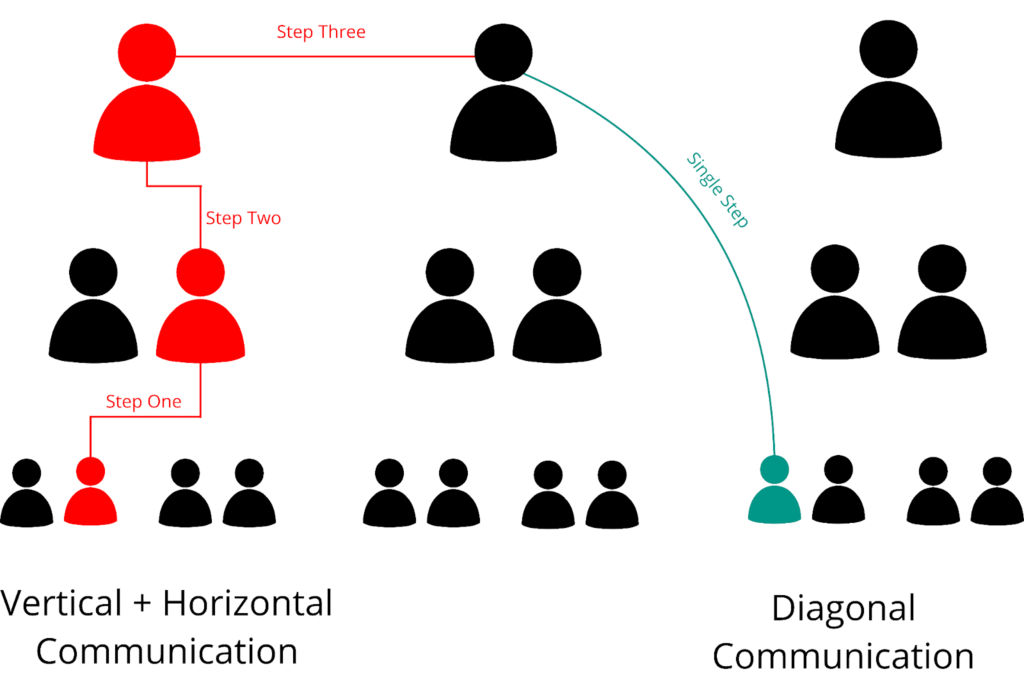Most businesses today are divided up into different departments, and each department has its own hierarchy. Business communications tend to follow these hierarchical and departmental lines.
On the one hand, information may travel up or down the hierarchy but stay within the same department. This is known as “vertical” communication.” A team leader speaking to members of their own team is an example of vertical communication. Everybody is in the same department, but the team leader is higher up in the company.
On the other hand, “horizontal” communication crosses departmental lines but stays at the same hierarchical level. An example of this is when the manager of one department speaks with the manager of another. Their rank is the same, but they are in different departments.
Diagonal communication, however, cuts across departments and hierarchies. It allows employees from one department to speak directly with employees from another, regardless of position or rank.
Diagonal communication “cuts across” departments and hierarchies.
When it’s done right, there are many benefits to diagonal communication. There are also some challenges, although most of these are easily solved by establishing best practices.
Read on to learn more about diagonal communication and how to implement it in your organization.
Advantages to diagonal communication
There are many advantages to diagonal communication. Here are some of the most important:
Quicker access to important information
Without diagonal communication, the flow of information is limited to vertical and horizontal communication. In these cases, more steps are needed to move information across departments and pay grades.
Imagine, for example, that a member of your product team wants to know more about customer expectations around a certain feature. The manager of the sales department is probably the best person to speak to.
Without diagonal communication, the product developer must first speak to their manager, who then communicates with a sales manager. If the product developer needs information from the Head of Sales or a senior manager, that’s one more step. Basically, the further apart in the hierarchy two people are, the greater the number of extra steps.
A faster solution is for the product developer to contact the sales manager directly. This takes just one step: product developer to sales manager.
Not only can work be completed more quickly, but it’s also less frustrating for the product developer.

Diagonal communication helps reduce the number of “steps” needed to share information.
Less chance of information being distorted or missed
More steps don’t just mean more time. The risk of information being distorted or lost increases with each person it passes through.
If you’ve ever played the game “Telephone”, you know just what this is like. To play, a group of people sit in a circle. One of them thinks of a word or phrase and whispers it in the ear of the person next to them.
That person whispers it in the ear of the next person, and so on. By the time it gets to the last person, the phrase has become so distorted, it’s unrecognizable!
Fewer steps mean less chance of information being distorted or lost in transmission.
Fewer distractions for team leaders
Most managers have more important things to do than pass messages between departments. In the scenario above, the product developer has to wait for the information to pass through their manager. But the manager’s time is also wasted when passing on a request for information to their colleague.
The more time managers spend acting as a “company switchboard,” the less time they have to innovate and problem-solve. Distractions like this also reduce job satisfaction and increase the likelihood of burnout.
Closer collaboration between departments
Horizontal communication was first introduced in an effort to improve collaboration between departments. It helped businesses to become more agile and respond more quickly to changes in customer expectations or market conditions.
Diagonal communication improves on this by enabling employees to seek out the information they need from team leaders in other departments. It also encourages managers to share knowledge with others beyond their own department and rank.
Ultimately, this leads to better-informed employees who have a broader view of the company’s operations.
Increased engagement and job satisfaction
Diagonal communication can help employees feel empowered. It encourages them to take a proactive approach to communication and take ownership over their work. There are fewer barriers to accomplishing objectives. All of this leads to greater job satisfaction and increased engagement.
Managers can also benefit greatly from diagonal communication. As mentioned above, less of their time is spent shuffling information around. This means more time for leadership, problem-solving, and creative thinking.
Plus, when it comes to engagement and satisfaction, what’s good for a team is good for its leader. An engaged, enthusiastic, and independent team is easier to manage than one that’s detached and unmotivated.

Download your FREE guide on “10 Tips for Engaging Your Frontline Teams” ⤵
Challenges to diagonal communication
As with all communication styles, there are certain challenges associated with diagonal communication. You may encounter some or all of the following.
Key players may be uninformed
The chain of command exists for several important reasons. One of those is that managers need to know what their team is doing and how they’re doing it.
If workers are overzealous in bypassing their own manager to get information, it can cause serious problems down the road. Managers who feel uninformed can also experience frustration.
There are several ways to avoid this problem. One strategy is to have regular formal or informal check-ins with team members. This can easily be done with a good internal communications app.
Employees can also be encouraged to CC their manager on diagonal emails or @tag them in diagonal message threads.
Finally, you could ask employees to keep a simple log or diary of what they’re working on and what resources they’re using.
Greater risk of miscommunication and misunderstandings
Different departments use different language and jargon, and may have established different styles of communicating. Individuals communicating with another department won’t be as familiar with that department’s workflow and style as with their own.
To help combat this, businesses should establish clear, company-wide standards for communication. For example, you can outline how to correctly request and deliver information to avoid misunderstandings or conflicts.
Questions and answers should be stated simply and directly, with as little jargon as possible. Finally, individuals should be prepared to go into greater detail when requesting or sharing information.
How to enable diagonal communication in the workplace
By now, you should have a good understanding of the benefits and challenges of diagonal communication. Here are a few key ways to ensure effective diagonal communication in the workplace.
Establish a set of guidelines for communicating diagonally
Communicating diagonally requires special attention to being clear and direct. Small cultural differences between departments must also be taken into account.
Start by writing up a list of guidelines for communicating diagonally. Think carefully about what kinds of information can and should be shared between departments. This is especially important for customer information, which may need to be kept private.
Encourage the use of clear, simple, and inclusive language. Foster active listening and two-way communication. Indeed, there are many ways to encourage effective communication in the workplace.
Share one copy of your guidelines with managers and another with workers. Encourage each group to make suggestions based on their needs and expectations.
Use these suggestions to come up with a final list that, as much as possible, satisfies both groups.
Encourage written over spoken diagonal communication
Most if not all diagonal communication should happen in writing. This can be accomplished with email or a company-wide chat platform like Connecteam.
This will help reduce the risks of miscommunication/misunderstanding. It also makes it easier for managers to stay in the loop. When issues arise with diagonal communication, you will have a written record to refer to.
This record can also help you understand how people are communicating diagonally. Use these insights to adjust your guidelines accordingly.

Limit the number of communication channels being used
This is a good idea for internal communications in general. Having too many channels makes it difficult to keep track of conversations and the flow of information.
But this is especially important for diagonal communication. In some ways, it adds a layer of complexity to communications—so everything else should be kept as simple as possible.
The easiest way to do this is to make use of a single communications platform, such as Connecteam. Such platforms provide simple solutions for horizontal, vertical and diagonal communication.
Focus on building an open and collaborative work culture
Diagonal communication thrives in work cultures that encourage transparency and collaboration. In fact, these values are essential to it. Hard lines drawn between departments and pay grades make diagonal communication more difficult. They discourage employees from contacting leaders outside their own department and limit knowledge sharing.
Plus, improved communication is just one reason why an inclusive and collaborative work culture is beneficial. Consider performing a culture audit to understand your company culture’s weak points. Then, create a plan for building a stronger one.
Conclusion
Diagonal communication enables employees to access and share information across traditional departmental and hierarchical lines.
There are many advantages, including closer collaboration, faster access to information, greater engagement and ownership, and fewer distractions for managers.
A clear set of guidelines and use of an internal communications platform can help ensure success.
Make Communication a Breeze with the #1 All-in-One Communication App
Keep your employees up to date, connected and informed wherever they are through your own communication app.




